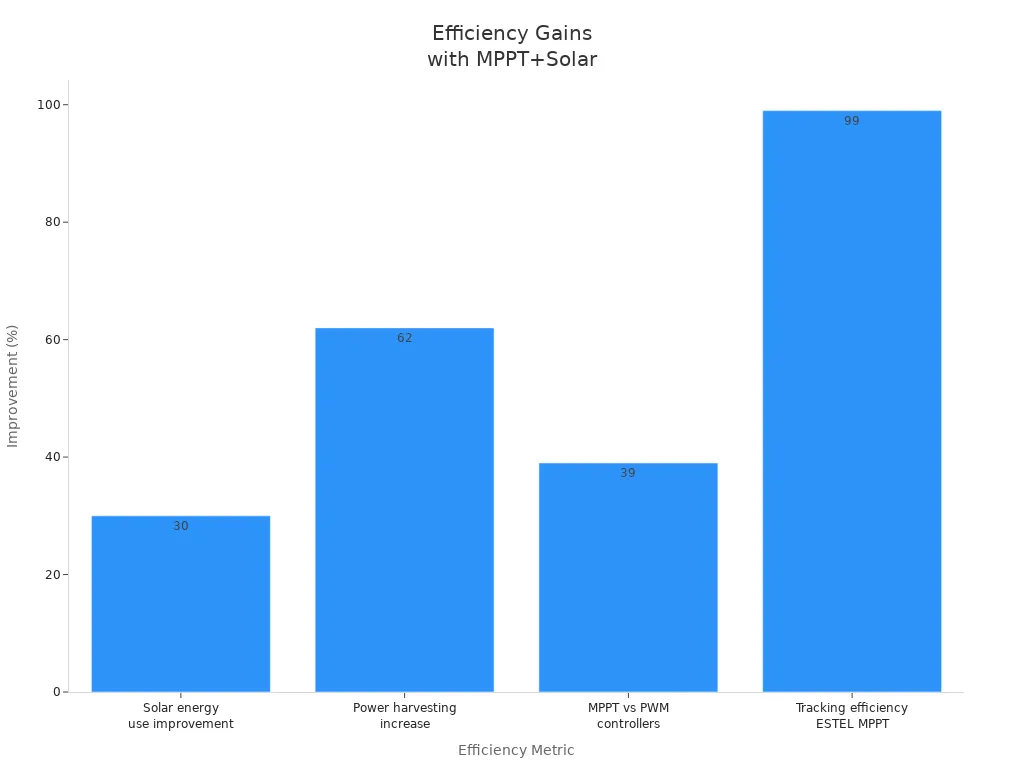MPPT+solar Modules: How to Solve 'Grid Fluctuation + Remote Power Supply' Challenges for Telecom Cabinets

MPPT+solar modules deliver stable, efficient, and cost-effective power for telecom cabinets facing grid fluctuation or remote supply challenges. Reliable energy supports continuous operation and protects sensitive equipment.
Operational costs drop by nearly 50% when switching from diesel generators to solar systems.
Maintenance needs decrease, with solar panels requiring only semi-annual cleaning and inspections.
Advanced MPPT controllers improve energy harvest and extend battery life, ensuring dependable performance even in off-grid locations.
Global telecom providers increasingly choose these solutions for rapid deployment, scalability, and long-term savings.
Key Takeaways
MPPT+solar modules provide stable and efficient power for telecom cabinets, solving issues caused by grid fluctuations and remote locations.
These systems reduce operational costs by up to 50% and lower maintenance needs with simple cleaning and remote monitoring.
Advanced MPPT controllers boost solar energy harvest by up to 30%, extending battery life and ensuring reliable power even in cloudy or unstable conditions.
Modular and weather-resistant designs allow easy system expansion and protect equipment from harsh environments.
Regular maintenance and remote monitoring improve uptime and help detect problems early, keeping telecom networks running smoothly.
Power Challenges

Grid Instability
Telecom cabinets often face unstable power supplies, especially in regions with high integration of renewable energy sources. The grid's ability to resist frequency changes, known as inertia, drops when solar and wind energy enter the mix. Lower inertia leads to faster and larger frequency swings during disturbances. These swings can cause outages, which disrupt telecom operations. Unstable national grids, frequent power outages, and technical failures in hybrid systems add to the challenge. Environmental factors such as dust, humidity, and cloudy weather also reduce solar panel efficiency and damage equipment. For example, dust storms in Sokoto or cloudy seasons in Jos can cut solar output by up to 60%. Humidity in coastal areas may damage inverters, making reliable power even harder to maintain.
Remote Locations
Many telecom cabinets operate in remote or hard-to-reach areas. These sites often lack access to stable grid electricity. Transporting fuel for generators increases costs and risks. Environmental conditions, such as dust accumulation or extreme weather, further complicate maintenance. Technical failures, like battery faults or inverter malfunctions, can go unnoticed for long periods. In these locations, solar panels may become misaligned or dirty, reducing their ability to charge batteries. Without regular inspections, automatic transfer switches or backup generators may fail to start when needed. Reliable power solutions must address these unique challenges to keep telecom services running.
Continuous Operation
Telecom networks require continuous power to avoid service interruptions. Sudden outages can damage sensitive equipment and cause data loss. Overcharging or overdischarging batteries reduces their lifespan and increases the risk of failure. Poor battery maintenance or manufacturing defects can lead to thermal runaway, which may cause fires or explosions. Environmental factors, such as high temperatures and humidity, accelerate wear and corrosion. Proper installation, weather-resistant enclosures, and regular maintenance help minimize these risks. Advanced battery management systems and fire suppression tools provide early fault detection and prevention. Reliable backup systems, such as UPS units, offer immediate power during outages, stabilize voltage, and protect against surges. These measures ensure that telecom cabinets continue to operate safely and efficiently, even during power disruptions.
MPPT Basics

MPPT for Power Optimization
MPPT technology plays a crucial role in extracting the maximum possible energy from solar modules, even when sunlight conditions change throughout the day. It acts as a smart electronic converter that constantly monitors the voltage and current from the solar panels. By adjusting the operating point, MPPT ensures the system always works at or near the maximum power point. This process allows telecom cabinets to benefit from up to 20-30% more power compared to systems without MPPT. Scientific studies show that MPPT algorithms can achieve efficiencies as high as 99.8%, especially under fluctuating sunlight, temperature changes, or partial shading. For example, on cloudy days or during early mornings and late afternoons, MPPT adapts quickly to maintain optimal energy harvest. This technology helps telecom operators maximize solar energy use, reduce reliance on backup generators, and lower operational costs.
Solar Integration
Integrating solar modules with telecom cabinet power systems requires careful planning and the right technical features. MPPT controllers must achieve high accuracy, often above 99.5%, to ensure efficient solar energy conversion. Telecom sites benefit from parallel operation of solar modules, batteries, and loads, which provides stable power supply. Over-voltage protection, hot-swap capability, and remote monitoring are essential for safe and reliable operation. Outdoor installations need enclosures with strong environmental protection, such as IP55 ratings, to withstand dust, rain, and temperature extremes. Energy-saving features like rectifier sleep mode and prioritization of solar input further improve system efficiency. A user-friendly interface with clear displays and alarms helps technicians manage the system easily.
Tip: Always select MPPT controllers and solar modules that match the specific environmental and operational needs of your telecom site.
Battery Management
Efficient battery management is vital for telecom cabinets, especially in remote or off-grid locations. MPPT controllers regulate the flow of electricity from solar panels to batteries, ensuring consistent and safe charging. They prevent overcharging and deep discharging, which can damage batteries and shorten their lifespan. Advanced MPPT systems offer features such as temperature compensation, automatic voltage regulation, and real-time monitoring. These functions help maintain battery health and extend service life. Safety features like overcharge protection and short-circuit prevention add another layer of reliability. Smart MPPT controllers also support remote diagnostics and data logging, allowing operators to detect issues early and schedule maintenance before problems occur.
System Benefits
Reliable Power Supply
Telecom operators need a power system that keeps networks running without interruption. MPPT+solar modules deliver this reliability by ensuring continuous power, even during grid outages or periods of low sunlight. These systems reduce dependence on diesel generators and unstable grids, which lowers operational costs and increases system autonomy. The network gains resilience by operating in autonomous or hybrid modes, protecting against external power disruptions. Modular and scalable designs allow easy expansion as power demands grow, supporting new technologies and network growth. Remote monitoring and control features enable proactive maintenance, reducing downtime and improving reliability.
Continuous power supply during grid failures or cloudy days
Lower reliance on diesel generators and unstable grids
Enhanced resilience through autonomous or hybrid operation
Easy system expansion for future network needs
Remote monitoring for quick issue detection and resolution
Note: Thousands of telecom sites worldwide use these systems to maintain network connectivity, even in remote or unattended locations.
Efficiency Gains
MPPT+solar modules maximize energy harvesting from solar panels, making telecom cabinet operations more efficient. MPPT controllers track the optimal power point, extracting up to 30% more energy compared to traditional controllers. Advanced algorithms achieve tracking efficiencies over 99%, ensuring reliable power output even when sunlight conditions change. Oversizing PV arrays with MPPT controllers increases system autonomy, especially during less sunny periods, and keeps batteries at a healthier state of charge. This approach reduces deep discharges and extends battery life.
Efficiency Metric | Improvement / Value |
|---|---|
Solar energy use improvement with MPPT vs traditional controllers | Up to 30% |
Power harvesting increase vs direct coupling methods | Up to 62% |
MPPT controllers outperform PWM controllers | Approximately 39% |
Tracking efficiency of advanced ESTEL MPPT algorithms (APO-MPC) | Over 99% |

MPPT technology achieves up to 95% power conversion efficiency, which maximizes solar panel utilization. More consistent solar energy production reduces the need for backup power sources, lowering overall energy consumption. Advanced microprocessor control and robust outdoor design ensure high conversion efficiency and reliable operation in harsh environments.
Reduced Maintenance
MPPT+solar modules help telecom operators cut maintenance costs and reduce site visits. Solar PV systems have no moving parts, so they avoid mechanical failures common in diesel generators. Operators report a 50% reduction in diesel generator runtime, which directly lowers maintenance expenses. MPPT controllers automate generator operation based on battery levels, saving fuel and reducing wear. Solar integration also decreases diesel transportation costs, especially for remote sites.
Fewer mechanical failures due to lack of moving parts
Lower generator runtime and maintenance needs
Automated energy management for optimal performance
Reduced fuel and transportation costs
Maintenance-friendly design with remote diagnostics
These systems also support environmental goals. By prioritizing solar energy and storing excess power in batteries, they reduce diesel generator use and cut carbon emissions by up to 70%. Intelligent energy management and remote monitoring optimize performance, support sustainability, and ensure 24/7 uptime.
Feature/Aspect | Description/Impact |
|---|---|
MPPT Solar Charging | High-efficiency solar input and battery charging. |
Solar First Operation | Solar PV powers the system during the day, reducing diesel use. |
Battery Storage | Stores solar energy for night use, minimizing generator runtime. |
Diesel Backup | Generator runs only when solar and battery are insufficient, cutting diesel fuel consumption. |
Carbon Emission Reduction | CO₂ emissions reduced by up to 70% compared to diesel-only setups. |
Intelligent Energy Management | AI-powered EMS and remote monitoring optimize system performance and longevity. |
Operational Benefits | Ensures 24/7 uptime with reduced fuel dependency and lower operational costs. |
Tip: Choosing MPPT+solar modules not only improves reliability and efficiency but also supports green energy initiatives and long-term cost savings.
Applications
Real-World Use
Telecom operators have deployed MPPT+solar modules in diverse environments to solve power challenges. The following table highlights several successful case studies:
Location | Year | Application | Products Used | System Size | Partners |
|---|---|---|---|---|---|
Rockstone, Guyana | 2022 | Telecom | SureSine SI-300-48-120-60-HW, TriStar TS-MPPT-45 | 1.5kW solar, 680Ah battery | coreNOC |
BC, Canada | 2011-2023 | Telecommunications | TriStar MPPT, ProStar MPPT, SunKeeper | Small off-grid (<5kW) | Hakai Energy Solutions |
Papua New Guinea | 2018 | Marine AtoN, telecom | TriStar TS-MPPT-60, SunSaver SS-10L, ProStarPS-15/30 | Not specified | M-NAV Solutions |
Peru | 2013 | Telecom VSAT network | TriStar 60, TriStar 60 MPPT, MeterHub, Relay Driver | Standalone solar-powered | CIME, Peru Ministry of Transportation |
Operators in these regions report improved uptime, reduced fuel costs, and longer battery life. Remote monitoring tools allow teams to track performance and respond quickly to faults.
Hybrid Systems
Many telecom cabinets use hybrid power systems that combine solar, grid, and generator sources. Eltek’s Flatpack2 Hybrid System integrates solar panels with Gen-set and mains power. A Smartpack2 controller manages all energy sources, energy flow, and storage. MPPT technology in the solar chargers optimizes energy harvesting, even when sunlight varies. The system supports up to 24 kW of solar capacity and uses hot-pluggable modules for easy upgrades. Advanced monitoring via Ethernet enables operators to control and troubleshoot sites remotely. Hybrid systems ensure reliable power for LTE, 4G, and broadband infrastructure, especially in areas with unstable grids.
Tip: Modular designs and remote monitoring make it easier to scale hybrid systems across multiple telecom sites.
Best Practices
Operators follow several best practices to maintain MPPT+solar module systems:
Use enclosures with IP55 or higher ratings to protect against dust and water.
Separate battery and equipment compartments to prevent acid mist damage.
Position batteries near enclosure walls with conductive pads for heat dissipation.
Employ Battery Management Systems to monitor voltage, current, and temperature.
Conduct routine inspections: clean panels, check cables, test voltage, and update firmware.
Train staff to recognize early warning signs and respond to system alerts.
Maintain detailed documentation of maintenance activities.
Schedule annual professional inspections for comprehensive system checks.
Regular cleaning and remote monitoring improve uptime by up to 20%. Operators avoid common mistakes such as skipping inspections or ignoring warnings. These steps ensure reliability, efficiency, and long-term performance for telecom cabinets using MPPT+solar modules.
MPPT+solar modules solve grid fluctuation and remote power supply issues for telecom cabinets by delivering stable, efficient energy. Operators benefit from over 99.5% accuracy in energy optimization, robust weather-resistant designs, and advanced monitoring for rapid fault resolution. Key advantages include reliable power, reduced costs, and sustainability.
Assess energy needs and site conditions before installation.
Choose modular systems for easy expansion and maintenance.
Use remote monitoring for proactive management.
Telecom operators can improve network resilience and efficiency by adopting MPPT+solar solutions.
FAQ
How does MPPT technology improve solar energy harvesting for telecom cabinets?
MPPT controllers track the optimal voltage and current from solar panels. They adjust settings to maximize power output. Operators see up to 30% more energy harvested compared to traditional controllers.
Tip: Regularly check MPPT settings for best results.
What maintenance tasks keep MPPT+solar modules running efficiently?
Operators clean solar panels every six months. They inspect cables, check battery voltage, and update firmware. Remote monitoring helps detect faults early.
Clean panels
Inspect wiring
Update software
Can MPPT+solar modules work in cloudy or rainy weather?
MPPT controllers adapt to changing sunlight. They optimize energy harvest even during cloudy or rainy days. Telecom cabinets continue to receive stable power.
Weather Condition | MPPT Performance |
|---|---|
Cloudy | High |
Rainy | High |
Sunny | Maximum |
What are the main benefits of using MPPT+solar modules in remote telecom sites?
Operators reduce fuel costs, lower maintenance needs, and improve uptime. MPPT+solar modules provide reliable power without frequent generator use. Battery life extends, and carbon emissions drop.
🌱 Sustainability improves with solar integration.
How can operators monitor and manage MPPT+solar systems remotely?
Operators use remote monitoring platforms. These tools track system performance, send alerts, and allow quick troubleshooting. Real-time data helps schedule maintenance and prevent outages.
Monitor energy output
Receive fault alerts
Schedule repairs
See Also
Solar Energy Storage Solutions Designed For Telecom Cabinets
Telecom Cabinets Using Grid-Tied Solar Inverters And Batteries
Steps To Guarantee Consistent Power For Telecom Cabinets
Methods For Calculating Power And Batteries In Telecom Cabinets
CALL US DIRECTLY
86-13752765943
3A-8, SHUIWAN 1979 SQUARE (PHASE II), NO.111, TAIZI ROAD,SHUIWAN COMMUNITY, ZHAOSHANG STREET, NANSHAN DISTRICT, SHENZHEN, GUANGDONG, CHINA

